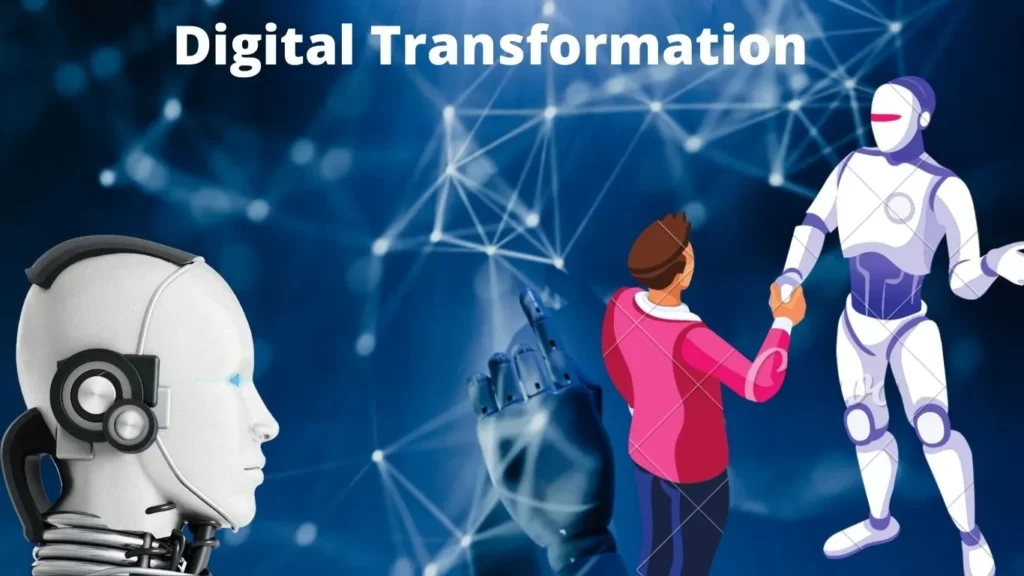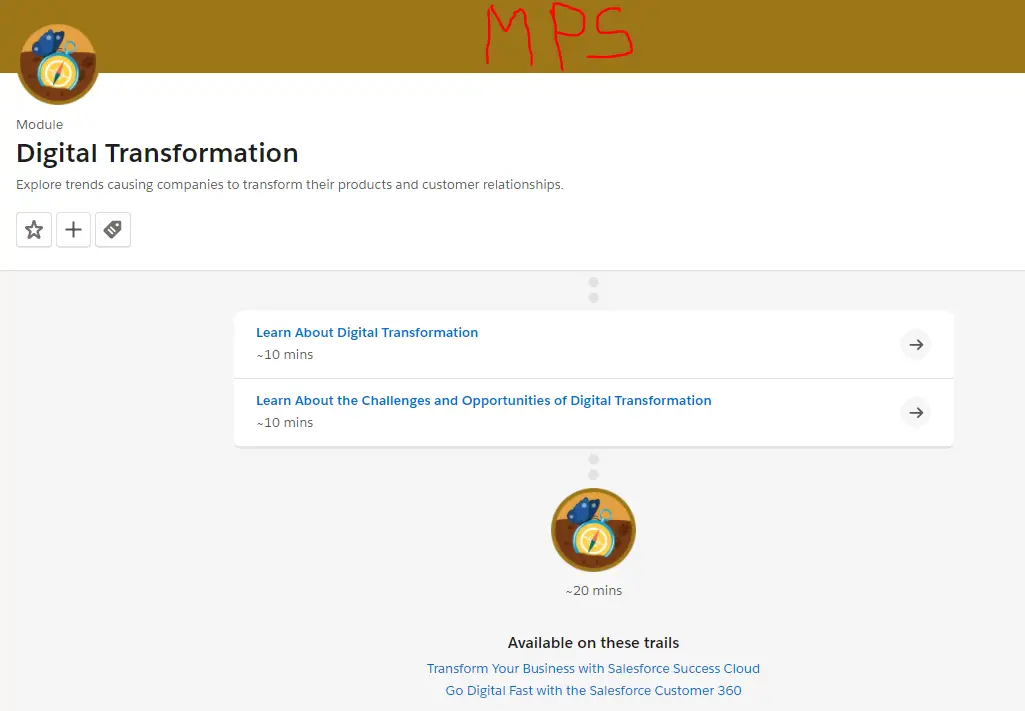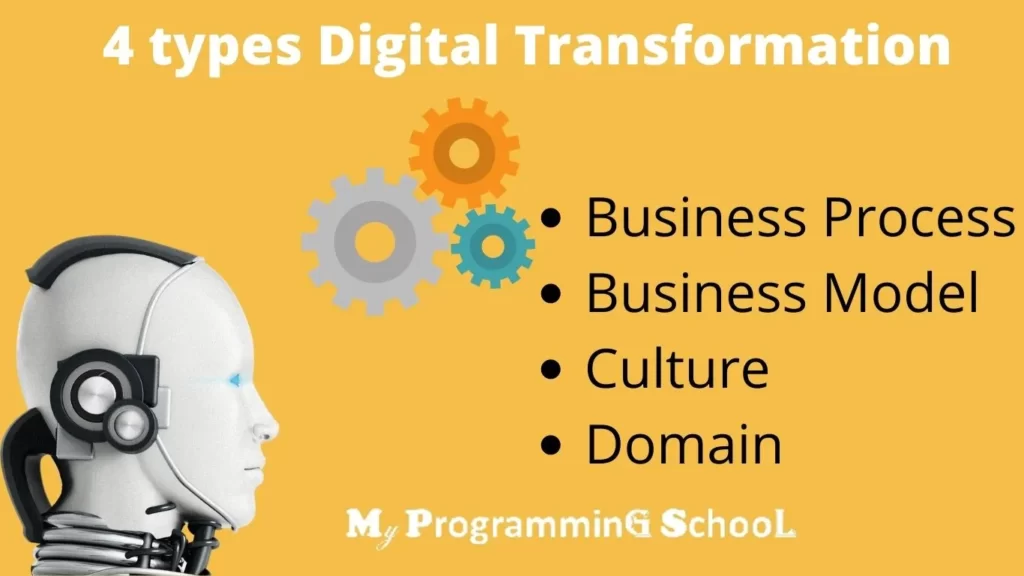Digital transformation can be defined as a combination of three things: technology, processes and culture. It is the process of transforming your business to benefit from the digital revolution. Some companies are using this opportunity to adopt new strategies and technologies that will bring about change.

#1.Learn About Digital Transformation

Q1)Why is company culture such an important component of any digital transformation project?
I)These kinds of initiatives usually involve significant change to people’s behaviors, and it’s critical to address those changes.
II)All companies should have the same culture and values in the Fourth Industrial Revolution.
III)Corporate culture has generally declined recently and needs to be restored.
IV)All Salesforce customers need to change their company culture.
[bg_collapse view=”button-green” color=”#4a4949″ expand_text=”Show Answers” collapse_text=”Hide Answers” ]
I)These kinds of initiatives usually involve significant change to people’s behaviors, and it’s critical to address those changes.
[/bg_collapse]
Q2)Which of the following statements reflects the design thinking approach to product development?
I)The best ideas always come from the product design team.
II)Empathy toward the end user is essential.
III)A well-designed product should be timeless and not need to change.
IV)It’s better to get a new product design “just right” before releasing it to customers.
[bg_collapse view=”button-green” color=”#4a4949″ expand_text=”Show Answers” collapse_text=”Hide Answers” ]
II)Empathy toward the end user is essential.
[/bg_collapse]
#2.Learn About the Challenges and Opportunities of Digital
Q1)Why do many digital transformation projects fail?
I)Not having people with the right skills to execute a complex project with new technology
II)Inadequate investment in training and change management resources
III)Executives overpromoting the transformation effort
IV)A and B
V)B and C
[bg_collapse view=”button-green” color=”#4a4949″ expand_text=”Show Answers” collapse_text=”Hide Answers” ]
IV)A and B
[/bg_collapse]
Q2)What kinds of business metric changes can result from a successful digital transformation effort?
I)Increased customer satisfaction reflected in survey results
II)A reduction in the number of needed employees
III)An increase in operational expenses
IV)An increase in capital expenses
[bg_collapse view=”button-green” color=”#4a4949″ expand_text=”Show Answers” collapse_text=”Hide Answers” ]
II)A reduction in the number of needed employees
[/bg_collapse]
What are the 4 main areas of digital transformation?
The digital transformation process is where the organization re-engineers itself to compete in the digital age. This is an ongoing, non-linear process where the business makes strategic investments in order to reduce costs and increase revenue.
There are four main areas of digital transformation:
- Developing Digital Strategies
- Building a Digital Platform
- Digitizing Operations
- Engaging the Customer.
What is digital transformation examples?
Digital transformation is the process of evolving your business or organization to better fit the needs of today’s digitally driven world. In other words, it’s a way for companies to merge their business model with the new digital technologies available.
Digital transformation success stories happen every day. A few years ago, IKEA used digital technology to completely change the way customers shop for furniture. Today, when you walk into an IKEA store, you’ll notice that it looks an awful lot like their website. It’s the same for many other companies.
What are the 3 key elements of digital transformation?
Digital transformation is fundamentally changing the way an organization operates, and it is the new frontier for businesses today. Over the past decade, we have seen major shifts in technology trends and business models that have given rise to disruptive innovations and a new normal.
With over 3 billion people using the Internet worldwide, digital transformation is defining how organizations can better serve their customers, employees, and partners through digital channels.
Digital transformation requires a blend of three key elements:
- Strategy: digital transformation is a business strategy that is applied to an organization’s operating model, enabling it to achieve its goals.
- Technology: digital transformation is enabled by the use of technology, and in many cases, new technologies must be developed for organizations to reach their goals.
- Culture: digital transformation is a change in corporate culture.
What are the types of digital transformation?
Digital transformation has become a buzzword that everyone is talking about. However, not many people really understand what it means.
There are four types of digital transformation:

- Business Process
- Business Model
- Culture
- Domain
- – Digital business transformation: This type of transformation aims to create new business models. For example, the transportation sector is introducing driverless cars and other innovative services.
- – Digital customer transformation: This type of transformation aims to create better customer experiences. For example, some companies are introducing personalization and AI chatbots to provide a better experience for their customers.
- – Digital product transformation: This type of transformation aims to improve products through new platforms.
- Culture: A redefining of organization mindsets, processes, talent, and capabilities for the digital world is always needed to achieve long-term digital transformation for any industry. The most successful corporations recognize that digital transformation requires a flexible workflow, a decentralized decision-making process, a bias toward testing and learning, and a greater reliance on different business ecosystems.
What are the top 3 trends of digital transformation?
Digital transformation is an ongoing process. As the technology landscape changes, so must the way in which we interact with it. The biggest shifts in web development have occurred over the last few years, and these will continue to impact the digital space for businesses worldwide.
The three most important trends that businesses need to keep on top of are:
- Responsive Design
- Domain Squatters
- Social Media Opportunities
What is the future of digital transformation?
When building a business, it’s important to keep an eye on the future. You need to know what is coming next so you can make decisions that will propel your company forward.
We’re at the cusp of digital transformation. With the way technology is moving, it’s hard to tell which way things are going to go. The only thing you can do is pay attention to what is happening now and try to make educated guesses about where things are going in the future.
One thing is clear: Things are changing quickly, and it will impact how we build our businesses.
how to do digital transformation?
Digital transformation is a very vague term. Yet, it’s a very important part of growing your business. According to the Harvard Business Review, companies that don’t implement digital transformation strategies are at risk of falling behind and losing out on potential business opportunities. If you want to transform your company into a digital powerhouse, here’s how to do it.
- Understand what digital transformation means to you:
Every company needs to understand what digital transformation means for them. Ask yourself the following questions: What does digital transformation mean? How can my company be transformed digitally? Who will be responsible for digital transformation? What is the vision for digital transformation? - Create a Digital Transformation Plan
The first step in creating a Digital Transformation Plan is to understand what digital transformation means to you. Once you have that understanding, you can begin to digital transformation? What will be the key enablers of digital transformation? - Create a vision for your digital transformation
Digital transformation is about moving from the old to the new, so you need to create a vision for what this means
how digital transformation impacts asset management?
Digital transformation is a term that has been used by companies for the past decade. It originally referred to the adoption of digital technologies like cloud, mobile and social media. These technologies have transformed the way we live, work and play, but they also have created new challenges for businesses.
Digital transformation does not simply refer to adopting new technology. It is a shift in business strategy, culture and mindset that creates an environment of innovation and experimentation. This article explores how digital transformation impacts asset management and outlines five ways to successfully implement a digital transformation strategy.
- 1.Define your vision
- 2.Get leaders involved
- 3.Focus on culture
- 4.Gather resources and expertise
- 5.Choose the right technology
how digital transformation is changing the world?
Digital transformation is a phenomenon that involves the restructuring of an organization using digital tools, processes, and thinking. Digital transformation can be used to improve existing business models that are either broken or no longer viable.
Digital transformation has the potential to disrupt most industries and change the way we do business today. Organizations are focused on digital transformation in order to create new business models and services, reduce costs and improve operational efficiency, increase revenues, stay ahead of competitors, and gain market share.
how digital transformation helps business?
Digital transformation is a process of continuous change in an organization to better meet customer requirements. Digital transformation is not just about technology, it’s about business change and its impact on customers, employees, and partners.
Digital transformation is a broad concept that covers the full spectrum of changes needed to deliver on the promise of digital business. Digital transformation requires cultural change and top-down vision from leadership that is capable of seeing beyond their own silos.
The goal of digital transformation is to create new value for customers across the entire customer experience. This begins with an analysis of the company’s current business model.
how digital transformation is changing project management?
Digital transformation is changing many aspects of the project management industry. The technology that is driving digital transformation is not compatible with traditional project management tools, so new software and processes have emerged to meet this new challenge.
As a result, many are adopting agile and lean project management methods to stay competitive in the digital business landscape. This has become evident in the way companies are hiring project managers as well. It seems as though project management skills have become a hot commodity, with the right candidates receiving multiple offers and sometimes even signing bonuses.
how digital transformation takes place?
Digital transformation has been taking place for at least the last 10 years, with companies looking to improve their business through the use of technology. Back then, digital transformation meant a company would incorporate new software in order to streamline processes, and make more money.
Today, digital transformation is much more complex than that. A company needs to be able to offer a complete experience online, not just have a place where they can sell their products. Everything a customer touches online should be as smooth as possible, from how they find the website, how they search for products and services, to how they pay for it and get it.
what is Digital Transformation Strategy?
Digital Transformation Strategy is now becoming one of the most important things in business today. It is a business strategy which aims at bringing about digital transformation in day-to-day operations of an organization. The digital transformation strategy is designed with a view to creating new products, adopting new technologies and processes while revamping old ones. This blog post explores top digital transformation strategies that will help you in winning business over your competitors.
Digital Transformation Strategies for Winning Business
- Mobile First Strategy: With the rise of mobile devices, the first digital transformation strategy that comes to mind is to develop a mobile-first strategy. This means developing your competitors.
- Be Transparent: Be transparent with your customers and clients about the products and services you offer, as well as your pricing structure. This will help them to make informed decisions about what to purchase.
- Become a ‘Customer-Centric’ organization In the digital era, the customers are the king and their demands have to be fulfilled at any cost. They expect instant service and an excellent customer experience. Therefore, the companies have to be proactive in order to meet their expectations. In this regard, they need to have a solid strategy that can help them in achieving their goals.
- Be Responsive: Be responsive to your customers and clients. Respond quickly to their inquiries, complaints, and suggestions.
- Be Consistent: Be consistent in the way you interact with your customers and clients.
why digital transformation is important?
The digital revolution has given way to the fourth industrial revolution, which is the most important business topic in the world. In 2017, Gartner, an information technology research and advisory firm, stated that a whopping 4.4 million jobs would be eliminated by 2020 due to automation.
What does this mean for the future of the workplace? The truth is that the future of work is already here, and it’s nothing like what we’ve seen before. The traditional office space is becoming less popular as more people turn to remote work. And that’s not all – Generation Z (those born after 1995) are the first generation to have never known a world without the internet. They’re used to having everything at their fingertips, and they’re more than happy to work from anywhere as long as they can get the job.
digital transformation in education:
For a long time, the education system operated in isolation. But today’s education is driven by technology.
The number of students who use digital textbooks has grown from almost nothing in 2005 to 25% of all students in 2012, and it continues to increase. There are now more than three million students with iPads and many institutions are now giving laptops to every one of their freshmen students.
Why is this new system emerging? Digital textbooks allow students to access an unlimited amount of information. Students can also highlight and take notes on the digital textbook itself. They can share these notes with each other, which is a great way to help students study together.
This technology is also great for teachers. Teachers can easily see what students are doing and where they are struggling. They can even track the reading speed of each student, which is very helpful when students are working on their reading skills. The online textbook also has a built-in dictionary, which is great for students who need help with difficult words. Students can even highlight the word and then hear it pronounced.
digital transformation in banking:
In the digital age, traditional institutions are being challenged by startups and new technologies like AI and Big Data. Retail banks are facing new internal and external challenges as well as opportunities for growth. This shift from cross-selling to upselling in the banking sector has changed the role of a bank’s core systems which include CRM, ERP, and BI.
With more customers becoming comfortable with mobile banking and payments, there is a lot of change in retail banking operations. Banks have been focusing on building mobile apps for their end users to make their banking experience more convenient and accessible.
Related Articles:
- What Is Audience Segmentation Strategy, Analysis, Tools With An Example
- Quick Start: Deploy A Java App On Heroku
- General Courses: Accountability And Delegation
- General Course: Blockchain Basics, Bitcoin, Cryptocurrency, Technology, Types
- General Courses: Culture Of Feedback, Types, Benefit, Important
- General Courses: Cyber Resilience
- General Courses: Demo Storytelling
- General Course: Digital Banking Basics-MPS
- General Courses: Demo Delivery Essentials
- General Courses: Google Analytics Basics
- General Courses: Great Management
